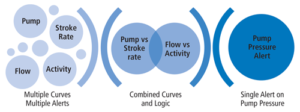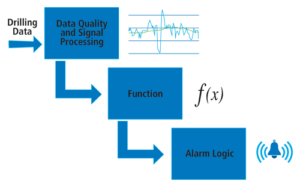Exception-based remote monitoring incorporates intelligence to enable early detection of well control events
Alarm service applies algorithms that emulate an engineer’s qualitative thinking to leverage real-time drilling data, improve well control
By Nazaad Baksh, Anil Wadhwa, Baker Hughes

Industry statistics suggest that the majority of well control incidents and near-misses occur during well construction operations. To address this issue, the industry has focused on stringent well design and casing standards, blowout prevention equipment, safe drilling practices and multiple layers of workflows and controls. However, the data also shows that most well control incidents occur as a result of human factors – misinterpretation of data, delayed response to abnormal well conditions, drilling crew inexperience and physical fatigue – that are not addressed by hydraulics and mechanical well control mechanisms.
Baker Hughes has developed the WellLink Alarm Manager service, an exception-based, real-time remote monitoring solution using the company’s WellLink software platform. The service is being used as a monitoring and detection mechanism for early identification of well control events and prevention of serious and possibly catastrophic incidents. The alarm manager service offers real-time drilling surveillance and alarm management services that detect and notify remote operations teams of problematic trends and enable them to take corrective actions in a timely manner (Figure 1).
Built to the ANSI/ISA-18.2 Alarm Management Standard, the alarm manager service leverages advanced signal processing capabilities, sophisticated algorithms and notification mechanisms to detect potential drilling hazards, such as fluid influxes, at an early stage while filtering out false alarms and alerting the right people in time to mitigate the risk. The service helps operators scale drilling operations with fewer personnel using an exception-based and escalation workflow. Major oil and gas operators are using this solution to enhance the operational awareness of their personnel at the wellsite and in their remote operations centers (RTOC).
Real-time drilling data
Real-time data has long been used by major operators for drilling optimization and well placement activities but not so much for well control. One industry safety authority identified 29 types of causes that can result in well control incidents and categorized them as human, organizational and technological factors. Real-time digital data holds significant promise for addressing all three factors by increasing the operational awareness of drilling crews, who can use the data to take precise and proactive actions to minimize well control risks.
The severity and consequences of a well control incident depend on the rate and volume of influx, alertness and competence of the drilling crew, availability and condition of safety equipment, availability and reliability of real-time digital data, and the decision support mechanism. Surface logging services leverage drilling data acquired from downhole sensors to provide valuable information about well status and drilling performance to help drill wells more efficiently. Drilling parameters typically include flow rate, pump pressure, standpipe pressure (SPP), pipe rotation (RPM), weight on bit (WOB), rate of penetration (ROP) and pit volume (PVT). This surface logging data can also be used to monitor influx and mud losses. Through real-time monitoring, surface loggers can identify trends that may indicate the onset of formation fluid influx, and take appropriate actions.
Several challenges limit the way current real-time drilling data technology can be used. Real-time streaming data from a single well can consist of 50 to 500 data channels/tags, making simultaneous and continuous monitoring difficult. Current technology requires determining the well condition from single-curve plots and generic alerts. This technique is time consuming and leaves room for errors that can hinder interpretation, analysis and decision making by the well team. The real-time alarm service described in this article overcomes many of these challenges.
Overcoming organizational, human factor challenges

The push to manage more wells with fewer people at the wellsite presents numerous challenges from organizational and human factors perspectives. For example, surface loggers’ ability to effectively interpret the well condition depends on their competence level, the quality and reliability of real-time data, and the human machine interface (HMI). In many cases, the combination of lack of field experience, reliance on logs with data quality issues, and physical fatigue from continuously monitoring and assimilating real-time streaming data can cause the logger to miss important trends that could have provided an early indication of influx.
The real-time alarm service applies complex alarming algorithms that emulate the qualitative thinking of a highly experienced drilling engineer and converts that knowledge as the well is being drilled to improve decision making across the team. In this way, the software solution is enabling an elementary form of intelligence to augment the human intelligence at the wellsite and in the RTOC, improving how conditions are recognized; what the thresholds are for potential issues downhole; how the team will react or not react. The service can be customized to account for characteristics and behaviors that vary with well location and conditions. This enables the operator to apply variations in the alarm conditions while using the same basic algorithms to identify abnormal events. Subject matter experts can define new rules and calculations, or customize pre-existing ones, to fit the configuration of the well, the rig and drilling activities being performed.
As illustrated in Figure 2, whenever an abnormal condition manifests itself in a well, the real-time operator (RTO) receives an alert and validates the well condition using various data logs. If the alarm is confirmed as positive and the condition warrants communication, the wellsite personnel are notified. The ultimate decision-making responsibility resides with the company representative or rig superintendent, who can now make decisions with confidence because they have full operational awareness.
Enhancing management by exception

A key challenge to identifying abnormal well conditions is the consistent interpretation of real-time data. Even with experienced RTOs, it is sometimes difficult to completely remove subjectivity. Well teams are increasingly adopting an exception-based approach to well and field monitoring to improve operational efficiency, safety and decision making.
However, the effectiveness of an exception-based monitoring system depends on the number of false positives, which can cause distractions that result in missing important alerts. This issue is partly addressed by incorporating intelligence into the exception-based approach.
The alarm manager service combines several data sets to detect an event based on predefined logic. Figure 3 presents an example. Parameters such as pump pressure, pump stroke rate, flow-in and rig activity, combined with logic, can alert the RTO to an abnormal change in the pump pressure that was not caused by a change in operations.
By applying the same logic throughout, inconsistencies between the RTOs can be reduced. The alarm manager automatically triggers the right alarm to the right individuals at the right time and provides them with the documented knowledge to solve or mitigate potential problems. The HMI in the application presents visible and audible alerts and enables the RTOs to validate the alerts with log curves.
Alarm management and human-machine interface

Based on industry experience, the user interface of traditional high-low alarm management applications is less than ideal for monitoring early kick detection at the wellsite or from a remote center. Raw data is often noisy, producing too many false positives that tend to overload the system and reduce the efficacy of real-time monitoring. The alarm manager service addresses this issue through multiple stages of signal processing.
The entire alarm management process consists of three stages (Figure 4).
In the first stage, to ensure data quality and reliability of interpretation by the RTOs, the raw data is processed using first-order filtering, dead-banding and outlier removal techniques to produce usable data without sacrificing accuracy. Data alignment techniques are applied to ensure data from various sources are accurately used in formula calculations. This ensures uniformity between the data indices, both time-and depth-based. Data gap processing techniques are applied to ensure the latest data are synchronized to provide accurate real-time outputs. If the data stream is interrupted, the functions that involve historical calculations are reset. The RTO can tune and adjust the degree of processing on a per-well basis.
In the second stage, a set of mathematical and custom functions based on pre-defined alarm conditions are used. Custom functions also can be created in a relatively short time using simple scripts. Analog data values are converted into a digital output or value change marker that indicates positive, negative, or no change. This approach makes it easier to compare changes in multiple parameters that are then used in the logic stage.
The application is designed with alarm logic that emulates the thought process of a drilling engineer. For example, the pump or SPP alarm looks at and trends the SPP changes as they relate to pump stroke rate (SPM). The alarm solution identifies changes in the SPP that are not consistent with the changes, if any, in SPM. The logic used in this alarm includes the rig activity, to avoid false alerts for pipe connections and other non-drilling activity, where SPP is not relevant.
The solution uses a modern non-relational database, which is designed for high-speed, high-volume data processing. This is a distributed database for managing large amounts of structured data across many servers. It provides high availability and performance, and scalability across multiple data centers. The application consumes many data formats, including the Wellsite Information Transfer Standard Markup Language (WITSML) data standard.
Operational example
In one major operator’s RTOC, the alarm manager system is being used to monitor data for a wide range of drilling parameters, including SPP, ROP, flow out and tank volumes. Alarm accuracy and consistency are measured periodically to determine the effectiveness of the system in identifying potential well control indicators. Alarms are tracked and grouped into four categories – alarm hits, alarm misses, alarm opportunities and not applicable. These are defined as follows:
• Alarm hit – A defined alarm sounds for an anomaly observed by the user.
• Alarm miss – An anomaly is observed but a defined alarm did not sound.
• Alarm opportunity – An alarm does not exist for this type of incident currently, but it would be useful to develop an alarm in this space in the future.
• Not applicable – An alarm is not required for this type of incident.
On one sample well, after the drillstring was pulled out of the hole, the well was flow-checked and observed to be static, which suggested there was no influx. One of three trip tanks was connected to the hole to ensure the annulus was always filled and to prevent any influx. The “Gains in Trip Tank” alarm activated after recording a gain of two barrels. This alerted the RTO, who acknowledged it and verified the gain using the real-time data, and then immediately contacted the wellsite using the escalation process and defined workflow.
The well was shut in and the pressures monitored while running in the hole to perform a successful well kill operation. The total initial influx before shut-in was less than three barrels. The ability to detect this threat at such an early stage enabled the rig crew to minimize the influx and prevent an escalation of the situation.
Results such as these have validated that the alarm manager service can effectively leverage real-time drilling data to help operators improve well control through quality assurance, 24/7 monitoring by experienced personnel, efficient human-machine interface, a reliable technology architecture, and robust communication workflows between the rig and remote center. DC
This article contains information from paper SPE-179368, “An Innovative Approach to Well Safety by Increasing Operational Awareness through Real-Time Monitoring,” presented at the 2016 SPE International Conference and Exhibition on Health, Safety, Environment, and Social Responsibility, held 11-13 April in Stavanger, Norway.




